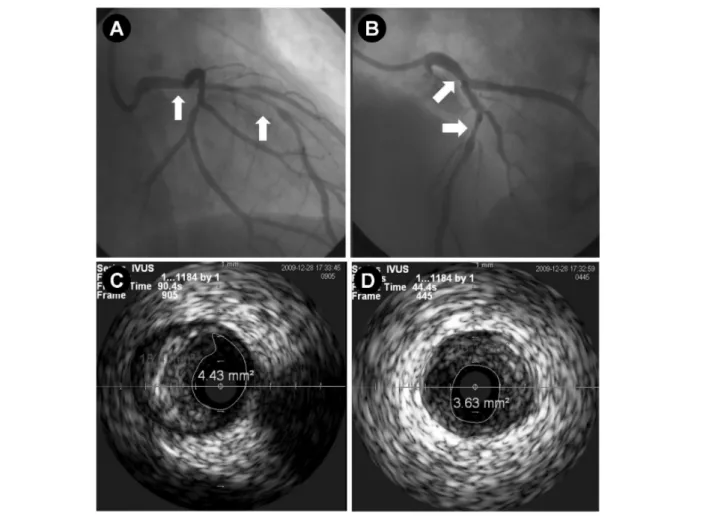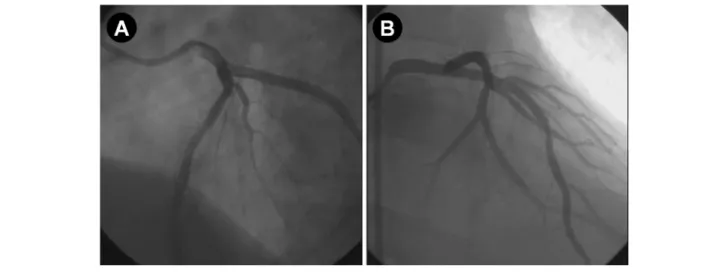J Lipid Atheroscler 2012;1(1):35-39
JLA
Sudden Cardiac Arrest in a Low-Risk Patient During Elective Spinal Surgery
Kyung Hoon Cho, Myung Ho Jeong, Min Chul Kim, Min Goo Lee, Keun Ho Park, Doo Sun Sim, Young Joon Hong, Ju Han Kim, Youngkeun Ahn, Jung Chaee Kang Korea Cardiovascular Stent Research Institute of Chonnam National University, Gwangju, Korea
Patients with intermittent claudication secondary to spinal problem may have asymptomatic cardiac disease. We experienced a case of sudden cardiac arrest in a low-risk male patient during elective spinal surgery which was performed in accordance with the current guidelines. A 54-year-old male, who did not have active cardiac conditions or clinical risk factors for perioperative cardiovascular events, was scheduled to have a planned surgery for spinal stenosis without preoperative testing for cardiovascular events according to the current guidelines. But, he developed sudden cardiac arrest during elective spinal surgery. Emergent coronary angiogram showed significant stenosis in the distal left main coronary artery and proximal left anterior descending coronary artery. We successfully deployed 2 bare metal stents with intravascular ultrasound guidance.
His mental state recovered and he was extubated 4 hours later. On day 8 in the hospital, he was transferred to the local hospital for care of his spinal problem.
Key Words: Sudden cardiac arrest, Spinal stenosis, Intermittent claudication
Received:
Accepted: February 28, 2012
April 9, 2012 Corresponding Author: Myung Ho Jeong, The Heart Research Center of Chonnam National University Hospital, 42 Jebong-ro, Dong-gu, Gwang-ju 501-757, Korea
Tel: +82-62-220-6243, Fax: +82-62-228-7174, E-mail: myungho@chollian.net
INTRODUCTION
Perioperative cardiac events are an important concern for the 234 million persons who have major noncardiac surgery worldwide every year.1 And, increasing numbers of patients, particularly the elderly, are undergoing surgery for spinal stenosis.2 The majority of patients with neurogenic claudication secondary to spinal stenosis may have asymptomatic or silent coronary artery disease (CAD) by virtue of their inactivity.3
We report a case of sudden cardiac arrest in a low risk male patient during elective spinal surgery which was performed in accordance with the current guidelines.
CASE REPORT
A 54-year-old man was brought to the Emergency Department in a comatose mental state. On the morning of presentation, he underwent neurosurgery for spinal stenosis at a neighborhood hospital. Towards the end of the operation, the anesthesiologist noticed sudden ST-segment elevation on the electrocardiogram (ECG) monitor, followed by wide QRS tachycardia, degenerating into ventricular fibrillation. Cardiopulmonary resuscitation was initiated and continued en route to our center by hospital staffs. After cardiopulmonary resuscitation for another 18 minutes at the Emergency Medical Center, he regained vital signs. He had no previous history of diabetes, hypertension, hepatitis, and pulmonary tuber-
Fig. 1. The initial electrocardiogram showed sinus tachycardia with ST-segment elevation in the precordial leads.
Fig. 2. A & B, His coronary angiogram showed significant stenosis in the distal LMCA to the proximal LAD with some filling defect suggesting intracoronary thrombus (A; RAO cranial view, B; LAO cranial view); C & D, Pre-PCI intravascular ultrasound showed large amount of plaque in the distal LMCA to the proximal LAD (C; distal LMCA, minimal lumen area: 4.43 mm2, plaque burden: 76%, D; proximal LAD, minimal lumen area: 3.63 mm2, plaque burden: 77%). (LMCA:
left main coronary artery, LAD: left anterior descending coronary artery, RAO: right anterior oblique, LAO: left anterior oblique, PCI: percutaneous coronary intervention).
Fig. 3. A & B, Final angiogram showed good distal flow without residual stenosis. (A; LAO cranial view, B; RAO cranial view). (LAO: left anterior oblique, RAO: right anterior oblique).
culosis. He was a 30 pack-years current smoker. His family history was non-specific. His blood pressure was 130/80 mmHg and his pulse rate was 90 beats per minute. On auscultation of the chest, inspiratory crackles were heard in both lower lung fields.
His initial ECG showed sinus rhythm with ST-segment elevation in the precordial leads (Fig. 1). The values of cardiac biomarkers were following: creatine kinase 145 U/L (35-172 U/L), creatine kinase-myocardial band 13.7 U/L (2.3-9.5 U/L), and troponin I 0.05 ng/ml (0-0.05 ng/mL). The chest X-ray demonstrated cardiomegaly, but no definite evidence of pulmonary edema. He underwent the emergent coronary angiography. His coronary angio- gram showed significant stenosis from the distal left main coronary artery (LMCA) to the proximal left anterior descending coronary artery (LAD) (B2, 85%, II) with some filling defects suggesting intracoronary thrombus (Fig. 2A, B). Pre-percutaneous coronary intervention (PCI) intravas- cular ultrasound (IVUS) showed large amount of plaque in the distal LMCA to the proximal LAD (Fig. 2C, D). Direct stentings using 3.5×25 mm bare metal stent (Coroflex Blue Stent, B. Braun Vascular System, Germany) from the proximal to middle LAD and another 4.0×25 mm Coroflex Blue Stent from the distal LMCA to proximal LAD were
performed. IVUS after stenting showed good apposition of the stent. Final angiogram showed good distal flow without residual stenosis (Fig. 3A, B).
His mental state recovered and he was extubated 4 hours later. We performed intensive management in the coronary care unit from day 1 to day 5 in the hospital, with continuation of heparin infusion and concomitant use of aspirin (300 mg/day) and clopidogrel (75 mg/day).
On day 5 in the hospital, he was referred to a general ward. After PCI, he did not complain of chest pain, but complained of back pain and left leg weakness. On day 8 in the hospital, he was transferred to the local hospital for care of his spinal problem.
DISCUSSION
We present this case to draw more attention to perioperative cardiovascular events in patients undergoing spinal surgery due to spinal stenosis. CAD continue to be the major cause of death in adult, and sudden cardiac death account for around half of death related to CAD.4 Patients with neurogenic claudication secondary to spinal stenosis have increased risk for CAD because of age and associated cardiac risk factors.3 As these patients cannot
ambulate significant distances to stress the cardiovascular system, they may have asymptomatic or silent CAD by virtue of their inactivity.3
Perioperative cardiac events in patients undergoing noncardiac surgery, which account for one third of perioperative deaths, are associated with increased hospital stay and long-term mortality rates.5-7 American College of Cardiology Foundation (ACCF) /American Heart Association (AHA) had drawn up updated guidelines for the perioperative cardiovascular evaluation of the patient undergoing noncardiac surgery in 2009.8 Our patient needed noncardiac surgery which was not emergent operation. He did not have any kind of active cardiac condition including unstable coronary syndrome, decom- pensated heart failure, significant arrhythmias and severe valvular disease. Regarding the patients’ risk of occurring perioperative cardiovascular events, spinal surgery belonged to the intermediate risk procedure. The func- tional capacity could not be checked due to his spinal problem. This patient had no clinical risk factors such as ischemic heart disease, compensated or prior heart failure, cerebrovascular disease, diabetes mellitus and renal insufficiency. Therefore, he was scheduled a planned surgery without preoperative testing for cardiovascular events according to the 2009 ACCF/AHA guidelines. Also, he did not take beta-blocker before his surgery because perioperative beta blocker therapy was not indicated. This patient followed this guideline appropriately, but he developed sudden cardiac arrest due to ST-segment elevation myocardial infarction during spine surgery.
One original article enrolled 140 patients who were scheduled to have elective lumbar spine surgery for symptomatic spinal stenosis.3 They did the sestamibi myocardial scan or dobutamine stress echocardiography before surgery. Eleven patients developed new abnormal wall motion on stress testing indicating myocardial ischemia. Of the four cardiac risk factors including hypertension, previous heart disease, diabetes and history
of smoking, previous heart disease and history of smoking were shown to be associated with ischemia on cardiac stress testing in this study. Several studies have implicated age as being significantly associated with symptomatic CAD.9-10 Based on the findings of previous studies, it was recommended that dobutamine stress echocardiography be used in patients undergoing elective spinal surgery for symptomatic spinal stenosis in any age, if the patient has a history of previous heart disease, smoking, or both, and in all patients 65 years of age or older.3 Considering the recommendation in this article, cardiac stress testing should have been used in our patient for preoperative evaluation.
Our case provides important messages for clinicians to evaluate the risk of perioperative cardiovascular events for patients undergoing noncardiac surgery. Patients with neurogenic claudication secondary to spinal stenosis have increased risk for CAD and may have asymptomatic CAD by virtue of their inactivity. Therefore, cardiac stress testing should be considered in patients undergoing elective spinal surgery for symptomatic spinal stenosis in any age, if the patient has a history of smoking, and in all patients 65 years of age or older. Furthermore, current guidelines on perioperative cardiovascular evaluation for noncardiac surgery should not be applied to all patients without individualized consideration.
REFERENCES
1. Weiser TG, Regenbogen SE, Thompson KD, Haynes AB, Lipsitz SR, Berry WR, et al. An estimation of the global volume of surgery: a modelling strategy based on available data. Lancet 2008;372:139-144.
2. Gunzburg R, Szpalski M. The conservative surgical treatment of lumbar spinal stenosis in the elderly. Eur Spine J 2003;12 Suppl 2:S176-180.
3. Faciszewski T, Jensen R, Rokey R, Berg R. Cardiac risk stratification of patients with symptomatic spinal stenosis. Clin Orthop Relat Res 2001:110-115.
4. Shin DG. Current Perspectives on Methods for Predicting Risk of Sudden Cardiac Death. Korean Circ J 2002;32:
637-645.
5. Devereaux PJ, Yang H, Yusuf S, Guyatt G, Leslie K, Villar JC, et al. Effects of extended-release metoprolol succi- nate in patients undergoing non-cardiac surgery (POISE trial): a randomised controlled trial. Lancet 2008;371:
1839-1847.
6. Fleischmann KE, Goldman L, Young B, Lee TH. Asso- ciation between cardiac and noncardiac complications in patients undergoing noncardiac surgery: outcomes and effects on length of stay. Am J Med 2003;115:515-520.
7. Landesberg G, Shatz V, Akopnik I, Wolf YG, Mayer M, Berlatzky Y, et al. Association of cardiac troponin, CK-MB, and postoperative myocardial ischemia with long-term survival after major vascular surgery. J Am Coll Cardiol 2003;42:1547-1554.
8. Fleisher LA, Beckman JA, Brown KA, Calkins H, Chaikof EL, Fleischmann KE, et al. 2009 ACCF/AHA focused update on perioperative beta blockade incorporated into the ACC/AHA 2007 guidelines on perioperative cardio- vascular evaluation and care for noncardiac surgery: a report of the American college of cardiology foun- dation/American heart association task force on practice guidelines. Circulation 2009;120:e169-276.
9. Goldman L, Caldera DL, Nussbaum SR, Southwick FS, Krogstad D, Murray B, et al. Multifactorial index of cardiac risk in noncardiac surgical procedures. N Engl J Med 1977;297:845-850.
10. Detsky AS, Abrams HB, Forbath N, Scott JG, Hilliard JR.
Cardiac assessment for patients undergoing noncardiac surgery. A multifactorial clinical risk index. Arch Intern Med 1986;146:2131-2134.

